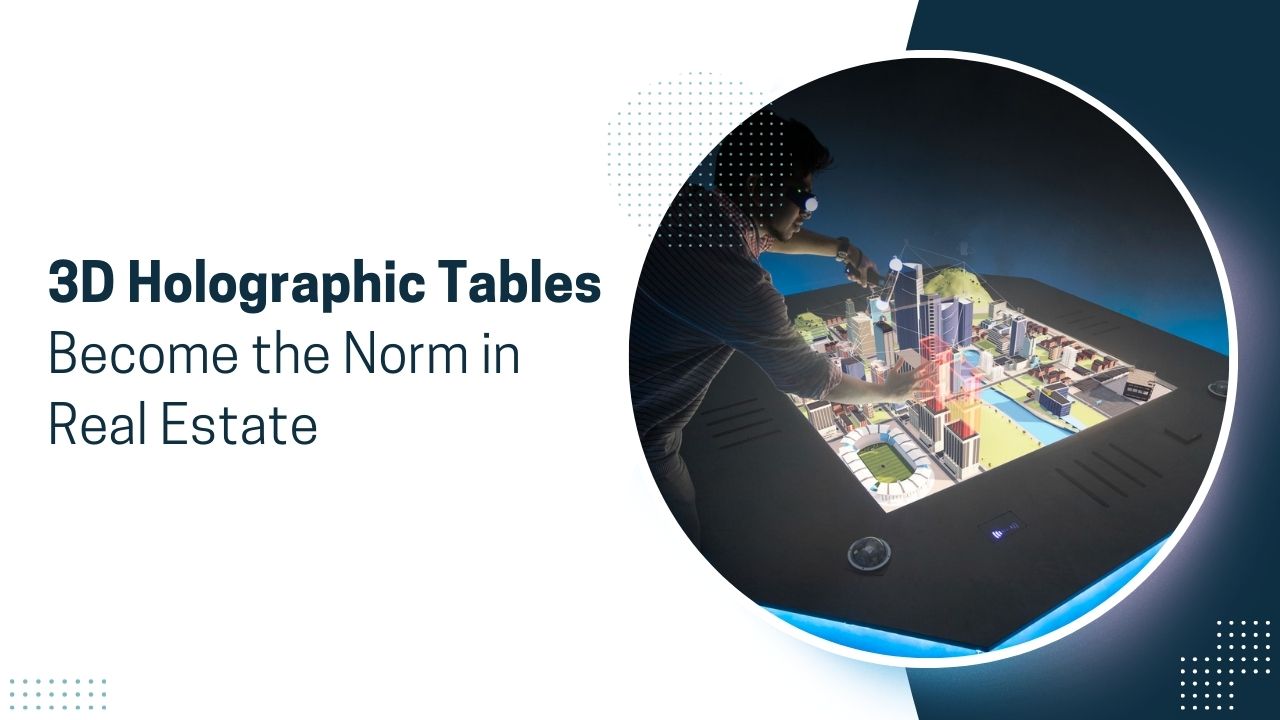In emerging real estate technology, one innovation proves a blessing in disguise i.e., the 3D holographic table. This technology looks like a science fiction movie. Its inclusion in the real estate industry has changed the way for commercializing, presenting and selling properties. But when can we expect 3D model holographic tables upliftment and significant usage? Let’s know about its pattern and engagement in detail here.


Explore the Impact of Cutting-Edge 3D Models and Pro Models in Revolutionizing Property Viewing. Dive into the Future Today!
3D Holographic Tables Overview
Before knowing about the effect of the holographic table, first, identify and be aware of 3D pro models and their functions. Essentially, these tables utilize holographic technology to project three-dimensional images onto a flat surface, creating the illusion of depth and dimensionality. Users can interact with these holographic representations, rotating, resizing, and exploring properties in a way that was previously impossible with traditional 2D images or even 3D models.
Current Structure and Selection Responsibilities
While the concept of a 3D model is mesmerizing, widespread choice in the real estate industry faces several hurdles. One significant challenge is the cost associated with implementing this technology. High-quality holographic tables require sophisticated hardware and software. This makes them prohibitively expensive for many real estate agencies and agents.
Additionally, there’s the issue of accessibility and familiarity. Many real estate professionals use traditional methods of showcasing properties, such as photographs, virtual tours, and physical open houses. Integrating 3D holographic tables into their workflow requires training and a shift in mindset, which may not happen overnight.
Essential Benefits of 3D Holographic Tables in Real Estate Industry
The potential benefits of engaging 3D holographic tables in real estate are substantial due to the above duties.
Enhanced Property Visualization
One of the most significant advantages of 3D pro models is their ability to provide immersive and realistic properties demo. Instead of relying on static images or pre-recorded videos, potential buyers can interact with lifelike 3D models. This pattern provides you with a better understanding of the property’s layout, dimensions, and features.
Remote Viewing Capabilities
In an era where remote work and virtual communication are increasingly prevalent, 3D holographic tables offer a solution for showcasing properties to clients. This facility is beneficial to those who are not able to attend in-person viewings. Through live-streamed holographic presentations, real estate agents can engage with clients from anywhere in the world. This offers a virtual tour experience that rivals being there in person.
Competitive Advantage
Early buyers of 3D holographic technology in the real estate industry stand to achieve a significant competitive advantage. With cutting-edge and memorable viewing experiences, agents and agencies can differentiate themselves from competitors. They can also attract more clients with 3D-pro models.
The Road to Choose – Duties and Opportunities
While the potential benefits of 3D holographic tables in real estate are undeniable. Their widespread adoption hinges on overcoming several key challenges.
Cost
As mentioned earlier, the cost of acquiring and implementing 3D holographic tables remains a significant barrier for many real estate professionals. However, as with any emerging technology, prices are likely to decrease over time as the technology matures and becomes more widely adopted.
Training and Education
Successfully integrating 3D models into real estate workflows requires proper training and education. Real estate agents and agencies must invest time and resources into learning how to effectively use this technology to showcase properties and engage with clients.
Technological Limitations
While 3D holographic tables offer an immersive viewing experience, they are not without their technological limitations. Factors such as resolution, refresh rate, and compatibility with existing software platforms may impact the usability and effectiveness of this technology in real-world scenarios.
The Future of Real Estate – A Pattern-Wise Shift
Despite these responsibilities, the future of real estate is undoubtedly heading towards greater integration of immersive technologies like 3D pro models. As the technology continues to improve and become more accessible, we can expect to see a gradual shift towards these innovative solutions for property showcasing and sales.
Conclusion
So, while 3D models may not yet be the norm in real estate, their potential to revolutionize the industry is undeniable. By offering enhanced property visualization, remote viewing capabilities, and a competitive edge, this technology has the power to transform the way properties are bought and sold in the digital age. As real estate professionals embrace these innovations and adapt to the changing landscape, we can look forward to a future where the traditional boundaries of property showcasing are transcended by the power of holographic technology. To compare and choose the perfect holographic displays, connect with Vision3D customer care number – +91-8971953451.
